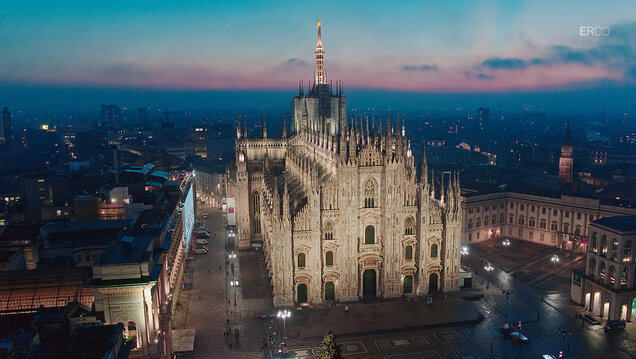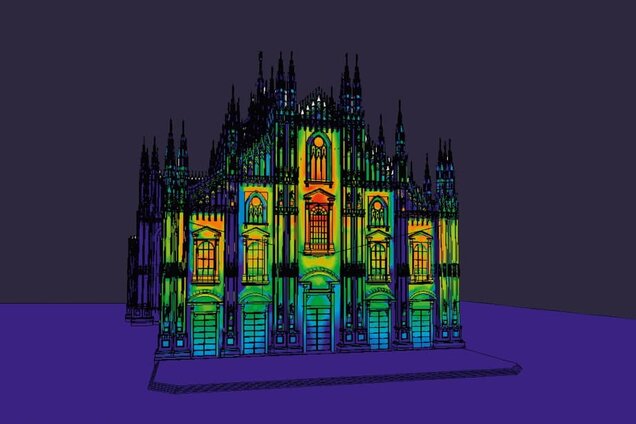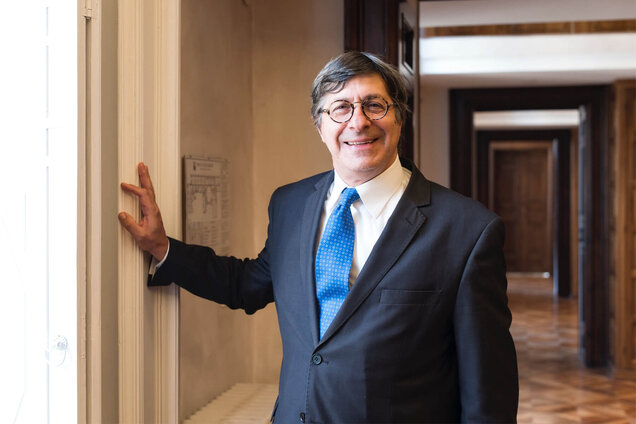»Now you can admire the cathedral down to the finest detail«

With DIALux evo, over 360,000 lighting design projects are conceived each month – including the cathedral in Milan. Both the interior and exterior lighting of the cathedral were implemented with DIALux evo. In an interview with ERCO made available to us, Pietro Palladino, the lighting designer responsible, describes which aspects of his concept have a particular impact.

The interview was conducted by Kristina Raderschad.
Kristina Raderschad (KR): Mr. Palladino, you are from Milan and have been living and working here for many years - can you describe the cultural significance of the cathedral for Milan, the role it plays in the fabric of the city?
Pietro Palladino (PP): I was not born in Milan, but after more than 30 years living and working here, I could pass as such. Not only is the cathedral one of the most impressive and most majestic works of Italian architecture, it also represents the heart of Milan, both geographically and emotionally. First of all, the city is characterised by its circular ground plan with the piazza at its centre from where it radiates into the suburbs. This purely geographical aspect then merges into a more personal dimension. The cathedral has a special sentimental value for the inhabitants of Milan, who hold it very dear. It is the symbol of their city, the figure of the "Madonnina" on top of the tower is like a beacon, a reassuring landmark when looking up to the sky.
KR: What was your basic design idea for the new exterior lighting of Milan Cathedral?
PP: The basic idea was to bestow on the cathedral an outer appearance commensurate with its importance. The average brightness of the general lighting around the piazza has risen steadily in recent years. Today, therefore, we need higher illuminance levels for the cathedral than those achieved by the system installed around twenty years ago.

KR: In 2015, in collaboration with ERCO, you redesigned the entire interior lighting of the cathedral, with around 800 LED luminaires from the Parscan family. Is there a relationship between your lighting design concept for the interior of the cathedral and the new exterior lighting?
PP: This project was more than simply exchanging objects; it was a complete redesign. Although the old system produced sufficient horizontal illuminance, it left the columns, capitals and side chapels of the church in half-light. In contrast to this, the new lighting concept prioritises the vertical surfaces, which is consistent with the intention of Gothic church architecture. We used a total of 860 luminaires in the interior, most of them with narrow beam optics. The high precision of their light distribution makes it possible to accentuate the capitals and many other details in the church interior with light. In addition, with the new exterior lighting, the large glass windows are brightly illuminated which allows them to be seen and admired from the interior. This creates real visual connections and makes it possible to perceive the architecture in its entirety.
KR: The new interior lighting of the cathedral with LED technology proved to be enormously energy efficient. To what extent does the new outdoor lighting also mean a gain in energy efficiency?
PP: After retrofitting a number of luminaires for special purposes, the electrical load for the interior lighting now totals 26.5 kW. For the outdoor lighting, the installed load is now 35 kW compared with a previous load of 58 kW, which represents a reduction of around 40%. At the same time, the average illuminance of the entire building has risen by 40%; this was previously 50-60 lx and is now 80-90 lx. The bottom line is that we have achieved energy savings comparable to that for interior lighting. We owe this first and foremost to the lighting technology of the ERCO spotlights which produce particularly precise light cones with little scattered light.
KR: Milan Cathedral is a landmark in a densely populated urban space. To what extent is the location a challenge when creating a lighting concept, also with consideration of the brightness of the surroundings? How can a building of this size be illuminated without affecting its immediate surroundings?
PP: In the past 20 years, there has been a large increase in the number of light sources around the cathedral. We have therefore increased the illuminance levels on the marble surfaces slightly. I also decided to use LEDs with a colour temperature of 4000 K to enhance the contrast with the surroundings and make details even more perceptible. On the one hand, the cathedral is already visible from a distance, on the other hand it is, above all, an integral part of the piazza and has a function here – after all, it dominates the piazza during the day.
KR: To what extent was the installation of the new outdoor luminaires affected by the cathedral’s status as a listed historical building? Where exactly were the new luminaires mounted or installed – including on the adjacent buildings? What were the particular challenges faced during installation?
PP: The spotlights have been mounted or installed at three different levels: first, on buildings at the edge of the square, then on light poles around the cathedral, and finally on the roof itself. The lighting installation goes to extremes in many respects: we have used a total of 650 spotlights of varying light distributions, some of which are more than 120 metres away from their focal points on the façade. The mounting height also varies greatly. We designed special support brackets for mounting the luminaires on the roof of the cathedral which do not cause any permanent damage to the original building material which is subject to a historic preservation order. In some cases, we needed industrial climbers and special tools to install the spotlights at high altitudes or in tight spaces, in accordance with the most critical aspects of the planning concept.
KR: Was there any testing on site?
PP: No, noon-site testing! When one considers the spatial conditions, a mock-up could not provide any meaningful insights here. On the contrary, false impressions could be created, leading the planner to make dangerous mistakes. We proceeded differently. On the basis of a computer model of the cathedral we simulated the lighting with two different programs.
KR: Italy has an enormous wealth of monuments such as churches and other historic buildings. Do you believe that the new illumination of Milan Cathedral will influence the future illumination of such monuments? In your opinion, where is the illumination of monuments heading at the moment?
PP: LED technology has changed lighting design. It is now possible to illuminate monuments from much greater distances than before, we can create higher contrasts and model shapes better. Our new exterior lighting for the cathedral confirms the claim that it is possible to illuminate not only equally well but actually better with reduced energy consumption. In the past you could look at the cathedral - now you can actually contemplate it, even analyse it. In my opinion, this is the most important difference that will drive the development of lighting design over the next few years.
The lighting designer
Pietro Palladino
The electrical engineer and lighting designer Pietro Palladino now knows Milan Cathedral like the back of his hand. He planned the exterior lighting in 2000, which he has now replaced with superior LED technology; in 2015 he completed the current interior lighting of the cathedral, also with ERCO lighting tools. Palladino, born in 1958, is regarded as an expert in the lighting of architectural monuments, which he effectively reinterprets while preserving the historical substance - for example the former customs station »Punta della Dogana« in Venice, converted into a museum. Lighting master plans for Milan and other cities and lighting for new buildings such as Venice Airport are also part of the repertoire of the Ferrara Palladino office, which he has been running in Milan together with his partner, the architect Cinzia Ferrara, for over 25 years.
www.ferrara-palladino.com